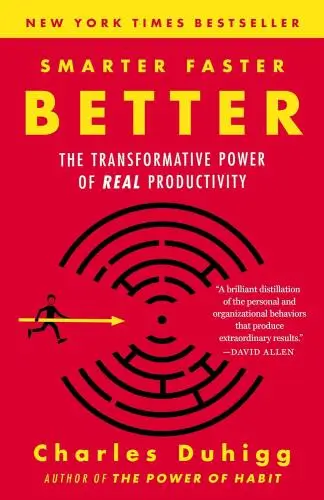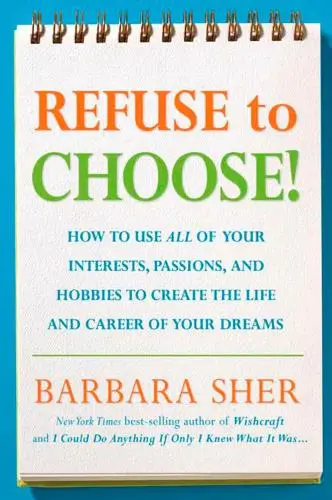
Smarter Faster Better
The Transformative Power of Real Productivity
What's it about?
Smarter Faster Better is a exploration of the science of productivity. Duhigg delves into the habits and routines of successful individuals and organizations to uncover the secrets of being more efficient and effective in our daily lives. From setting stretch goals to harnessing the power of mental models, this book offers practical strategies to help you achieve your goals and make the most of your time. If you want to work smarter, not harder, this book is a must-read.
About the Author
Charles Duhigg is a Pulitzer Prize-winning journalist and author known for his insightful explorations of human behavior and productivity. His best-selling book, "The Power of Habit," delves into the science of habit formation and how it impacts our lives. Duhigg's writing style is engaging and accessible, with a talent for weaving together captivating narratives and research-based insights. He offers a fresh perspective on the power of habits, the psychology of decision-making, and the potential for personal and professional transformation.
10 Key Ideas of Smarter Faster Better
Motivate Yourself by Framing Your Choices as Empowering Decisions
To enhance motivation, it's crucial to perceive the tasks ahead not as impositions but as choices you've made.
This mindset shift transforms obligations into opportunities, fostering a sense of control and autonomy.
When you frame your actions as decisions rather than chores, you're more likely to engage with them positively, boosting your motivation and productivity.
This approach leverages intrinsic motivation, which is driven by internal rewards like personal satisfaction and interest in the task, leading to more sustained engagement and better outcomes.
Learn DeeperIdentify Your Choices: Start by recognizing the decisions you make daily. Whether it's choosing to start a project, exercise, or even read a book, acknowledge that these are choices you're making, not obligations forced upon you.
Reframe Your Tasks: Once you've identified your choices, consciously reframe them as empowering decisions. For instance, instead of saying 'I have to work on this project,' say 'I choose to work on this project because it leads me closer to my goals.'
Set Personal Goals: Align your tasks with personal goals or values. This connection makes the task more meaningful and enhances your motivation to complete it. For example, if you value learning, frame a work assignment as an opportunity to gain new knowledge.
Celebrate Small Wins: Recognize and celebrate the completion of tasks, no matter how small. This reinforces the idea that you are in control and making progress by choice, which can boost your motivation and satisfaction.
- Example
Imagine you're not particularly excited about starting a fitness routine. Instead of thinking, 'I have to exercise because my doctor said so,' reframe it as, 'I choose to exercise to feel stronger and more energetic.' This mindset shift can make the activity feel more like a personal decision rather than a chore.
- Example
Consider a scenario where you need to clean your home but find the task daunting. Reframe it by thinking, 'I choose to clean my house today because I love living in a clean environment, and it makes me feel calm and happy.' This perspective turns cleaning from a tedious task into a positive, self-chosen action.
Set SMART Goals to Clarify Your Objectives and Measure Success
SMART goals—Specific, Measurable, Achievable, Relevant, and Time-bound—provide a clear roadmap for what you want to accomplish.
By defining your objectives with these criteria, you ensure that your goals are well-articulated and attainable within a specific timeframe.
This clarity helps in planning and prioritizing tasks effectively, making it easier to track progress and adjust strategies as needed.
Setting SMART goals also aids in maintaining focus and motivation, as each milestone achieved serves as a tangible indicator of progress.
Learn DeeperDefine Your Goal Clearly: Start by writing down exactly what you want to achieve. Be as specific as possible. For example, instead of saying 'I want to save money', say 'I want to save $5,000 for a vacation'.
Make It Measurable: Determine how you will measure your progress towards this goal. In the savings example, you could track your progress by setting monthly savings targets.
Ensure It's Achievable: Set a goal that is challenging yet possible to achieve with the resources and time you have. If saving $5,000 in a year seems too ambitious, adjust the amount or extend the timeframe.
Relevance Matters: Choose goals that are important to you and align with your long-term objectives. Saving for a vacation might be relevant if relaxation and travel are your priorities.
Set a Deadline: Having a specific timeframe in mind keeps you focused. Decide when you want to achieve your goal by, such as saving $5,000 by next December.
- Example
If you're aiming to improve your physical health, a SMART goal could be: 'I want to run a 5K in under 30 minutes by the end of six months, by training three times a week.'
- Example
For career advancement, a SMART goal might be: 'I aim to gain a promotion to senior manager within the next year by completing three additional leadership training courses and leading a successful project team.'
Foster Innovation by Encouraging Intellectual Disagreement
Innovation thrives in environments where diverse perspectives are welcomed and intellectual disagreements are seen as opportunities for growth rather than conflicts to avoid.
Encouraging team members to challenge ideas and propose alternative solutions stimulates critical thinking and creativity.
This approach prevents groupthink and ensures that decisions are well-considered from multiple angles, leading to more innovative and effective solutions.
It's important to create a culture where dissent is respected and valued as a tool for learning and improvement.
Learn DeeperEncourage Open Dialogue: Make it a point to regularly ask for opinions and alternative viewpoints during meetings. This can be as simple as saying, 'Does anyone see this differently?' or 'I'd love to hear a counterpoint to this approach.'
Create a Safe Space for Dissent: Establish clear norms that it's not only okay to disagree but encouraged. You might start a meeting with a reminder that all perspectives are valuable and that challenging the status quo is a way we grow.
Celebrate Diverse Thinking: When someone offers a unique perspective or challenges an idea, acknowledge and thank them publicly. This reinforces the behavior and shows the team that diverse thinking is appreciated.
Implement a 'Devil's Advocate' Role: Rotate this role in meetings where the designated person is encouraged to question and challenge ideas constructively. This ensures that there's always a voice pushing the group to consider different angles.
- Example
In a product development team meeting, the project leader asks for feedback on the proposed design. One team member suggests an alternative approach that hadn't been considered, which leads to a productive discussion about potential improvements. The project leader thanks the team member for their contribution, highlighting the value of bringing new ideas to the table.
- Example
During a strategy session, a manager introduces the 'devil's advocate' role. A team member assigned to this role challenges the feasibility of the timeline for a new project, prompting the team to re-evaluate and adjust their plan to be more realistic. This intervention prevents the team from committing to an unachievable deadline and demonstrates the importance of critical evaluation.
Enhance Focus Using Mental Models to Anticipate Challenges
Mental models involve visualizing future events, including potential obstacles and ways to overcome them.
By constructing these scenarios in your mind, you can prepare for various outcomes and develop strategies to navigate challenges more effectively.
This proactive approach not only enhances focus by keeping you mentally engaged with your goals but also improves problem-solving skills and adaptability.
Anticipating challenges reduces the likelihood of being caught off guard, allowing for smoother execution of tasks.
Learn DeeperVisualize Your Day: Every morning, take a few minutes to envision your day ahead. Picture the meetings, tasks, and any potential challenges you might face. Think about how you'll handle these situations and what success looks like for each scenario.
Prepare for Obstacles: When planning a project or task, identify potential obstacles in advance. For each obstacle, brainstorm possible solutions or strategies to overcome it. This prepares you mentally to tackle challenges as they arise.
Reflect on Past Experiences: At the end of the day or week, reflect on what went well and what didn't. Use these reflections to update your mental models and improve your strategy for similar future events.
Practice Mindfulness: Engage in mindfulness exercises to improve your focus and mental clarity. This can help you become more aware of your thoughts and better equipped to construct useful mental models.
- Example
Imagine you have a crucial presentation at work. You visualize not only the presentation itself but also potential questions from your audience, technical difficulties, or time constraints. You then think through how you'd handle each situation, making you feel more prepared and confident.
- Example
Before a family road trip, you anticipate challenges such as traffic jams, car troubles, or restlessness from the kids. You mentally prepare by planning alternative routes, packing an emergency kit, and bringing along games and snacks to keep the kids entertained. This preparation helps make the trip smoother and more enjoyable for everyone.
Boost Productivity by Managing Cognitive Load
Cognitive load refers to the total amount of mental effort being used in the working memory.
To boost productivity, it's essential to manage this load by breaking down complex tasks into smaller, more manageable parts and eliminating unnecessary distractions.
Prioritizing tasks based on their importance and urgency helps in allocating cognitive resources efficiently, ensuring that high-priority tasks receive the attention they deserve.
Techniques such as batching similar tasks together can also reduce cognitive load by minimizing the need for context switching.
Learn DeeperBreak Down Tasks: Start by dividing complex projects into smaller, more manageable tasks. This can make the overall project seem less daunting and help you focus on one thing at a time.
Prioritize Wisely: Each morning, or at the start of your work session, take a few minutes to list your tasks for the day. Then, rank them based on urgency and importance. Focus on completing high-priority tasks first.
Eliminate Distractions: Identify what commonly distracts you during work or study sessions (social media, emails, noise, etc.) and take steps to minimize these distractions. This might mean turning off notifications or finding a quieter place to work.
Batch Similar Tasks: Group similar tasks together and tackle them in one go. For example, if you have multiple emails to send, do them all at once rather than sporadically throughout the day. This reduces the cognitive load associated with switching between different types of tasks.
- Example
If you're working on a large report, break it down into sections like research, writing, and editing. Focus on completing one section before moving on to the next.
- Example
When planning your day, decide that the first hour will be dedicated to high-priority tasks, such as finishing a project proposal, before moving on to less critical tasks like responding to non-urgent emails.
Deeper knowledge. Personal growth. Unlocked.
Unlock this book's key ideas and 15M+ more. Learn with quick, impactful summaries.
Read Full SummarySign up and read for free!
Smarter Faster Better Summary: Common Questions
Experience Personalized Book Summaries, Today!
Discover a new way to gain knowledge, and save time.
Sign up for our 7-day trial now.
No Credit Card Needed

Similar Books

Hyperfocus
Chris Bailey
The Miracle Morning
Hal Elrod
Refuse to Choose!
Barbara Sher
The Power of Habit
Charles Duhigg
Make Your Bed
William H. McRaven
The Checklist Manifesto
Atul Gawande
The 4-Hour Workweek
Timothy Ferriss
The Life-Changing Magic of Tidying Up
Marie Kondō
Getting Things Done
David Allen
Deep Work
Cal NewportTrending Summaries

Peak
Anders Ericsson
Never Split the Difference
Chris Voss
Smart Brevity
Jim VandeHei
The Psychology of Money
Morgan Housel
The First 90 Days
Michael D. Watkins
Atomic Habits
James Clear
Thinking, Fast and Slow
Daniel Kahneman
The Body Keeps the Score
Bessel van der Kolk M.D.
The Power of Regret
Daniel H. Pink
The Compound Effect
Darren HardyNew Books

Job Interviews For Dummies®
Joyce Lain Kennedy
Job Interviews In A Week
Alison Straw
Handbook of Career Development
Gideon Arulmani
The Art of Spending Money
Morgan Housel
$100M Offers
Alex Hormozi
A Candle for Kiri
Edna Mae Holm
Principles of Marketing, Global Edition
Gary Armstrong
Serpent Rising: The Kundalini Compendium
Neven Paar
Feeling Is the Secret
Neville Goddard
